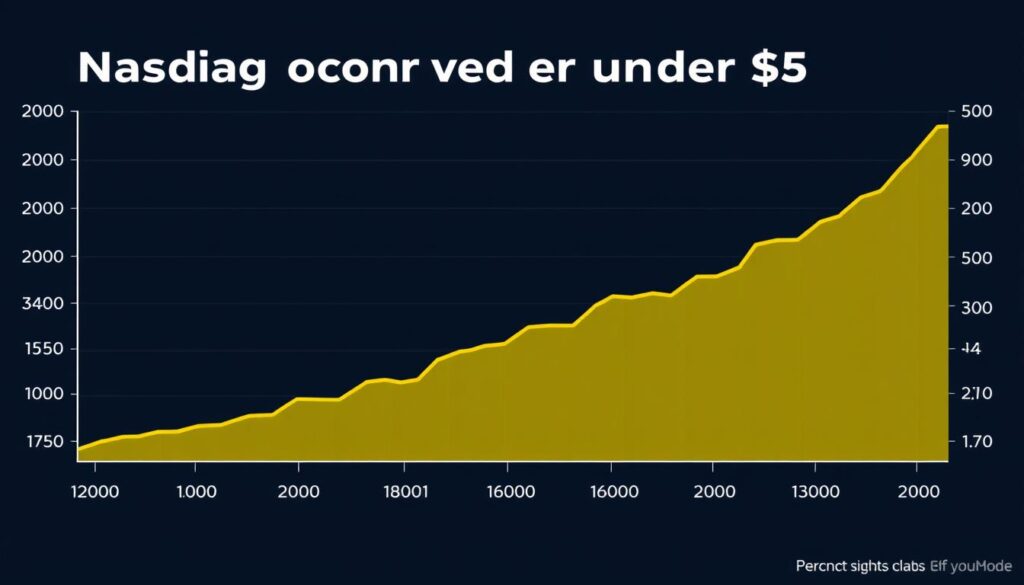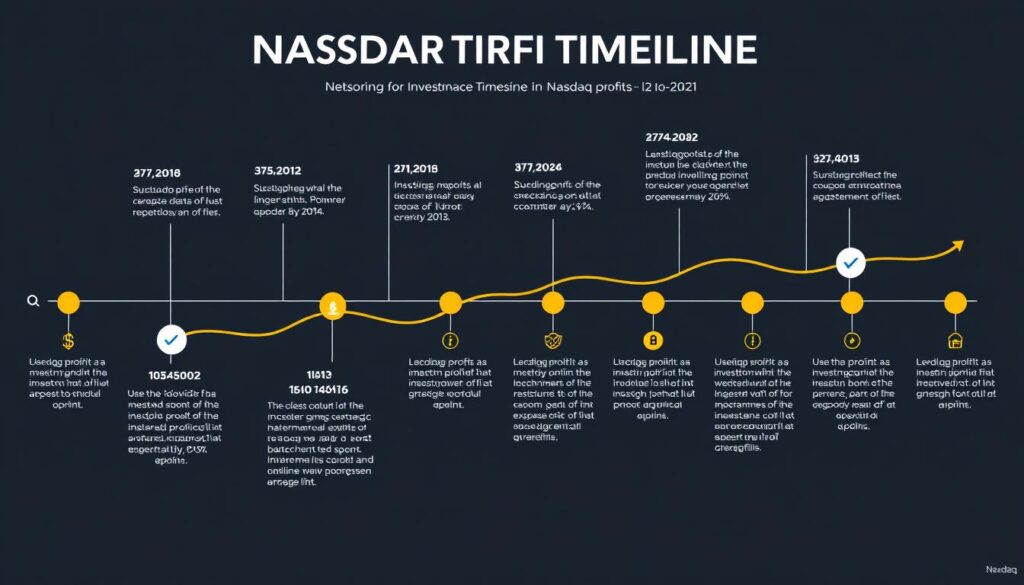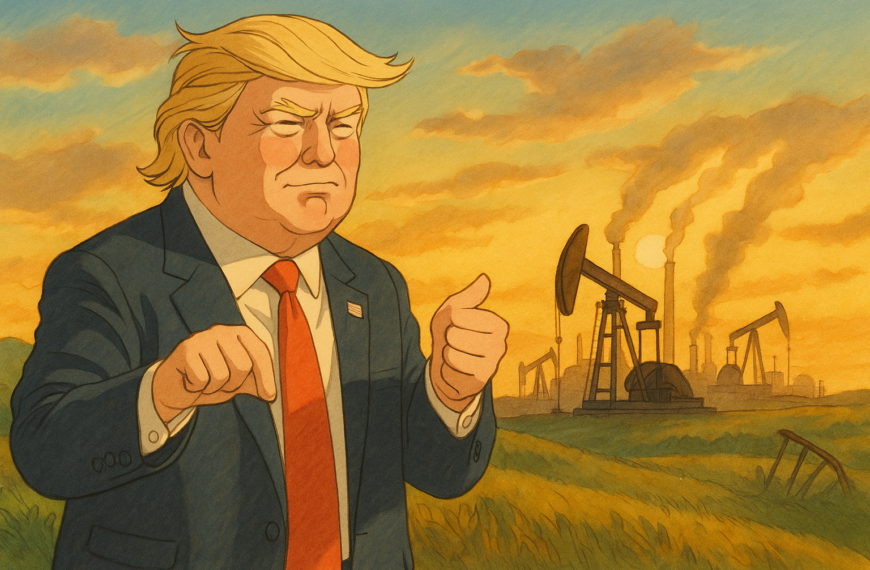The recent executive order imposing a minimum 10% tariff on all U.S. imports has sent shockwaves through the market, causing a significant decline in the Nasdaq Composite.
As investors scramble to respond to this new trade policy, savvy traders are identifying unique buying opportunities in the small-cap technology sector.
The imposition of higher tariffs on imports from 57 specific countries has fundamentally altered the investment landscape, creating both challenges and opportunities for growth in the United States.
As the market continues to adjust to this new reality, it’s essential for investors to stay informed and adapt their strategies to maximize profit potential on Wall Street.
Key Takeaways
- Identify undervalued assets in the small-cap technology sector.
- Understand the economic impact of the new tariff policy.
- Analyze sectors poised to benefit from the changes.
- Develop a strategic investment timeline to maximize profit.
- Stay informed to adapt investment strategies to the new trade reality.
The Market Shock: Understanding Trump’s Tariff Announcement
Trump’s tariff announcement sent shockwaves through the market, causing unprecedented volatility. The sudden change in trade policy left investors scrambling to adjust their strategies, leading to a significant market downturn.
The April 2025 Tariff Executive Order
The April 2025 Tariff Executive Order introduced a new era of trade policy, characterized by sweeping tariffs on imported goods. This move was seen as a bold step by the administration to reshape the global trade landscape. The tariffs imposed are expected to have far-reaching consequences for global supply chains and corporate earnings.
Market’s Initial Reaction: $6 Trillion Wipeout
The market’s reaction to Trump’s tariff announcement was swift and severe. Investors responded by selling everything except bonds, as the uncertainty surrounding future corporate earnings mounted. The Dow Jones Industrial Average hemorrhaged more than 3,900 points in a two-day span, a record drop that reflected the profound uncertainty introduced into the market.
- The market’s reaction was characterized by a historic $6 trillion wipeout in just two days of trading, highlighting the significant impact of the tariff announcement.
- The Nasdaq Composite entered bear market territory, with technology stocks facing particular pressure due to their global supply chains.
- Wall Street analysts struggled to model the impact of such sweeping tariffs, leading to a lack of clear guidance from many companies.
- The extreme market reaction stemmed from fundamental uncertainty about future corporate earnings in an environment where global supply chains face significant disruption.
As the market continues to navigate this new reality, understanding the implications of Trump’s tariff announcement is crucial for investors and companies alike. The impact on manufacturing, consumers, and the overall economy will be closely watched in the coming months.
Economic Impact of Trump’s Tariff Strategy
The economic impact of Trump’s tariff strategy is multifaceted, influencing GDP, wages, and global trade dynamics. The current tariff policy represents a significant shift in the United States’ economic approach, moving away from decades of free trade consensus.
Projected GDP and Wage Reductions
The implementation of Trump’s tariffs is expected to have far-reaching consequences on the U.S. economy. Studies suggest that the tariff rate could lead to a reduction in GDP, as higher costs for imported goods are passed on to consumers and businesses. This, in turn, may result in decreased consumer spending and investment, ultimately affecting wage growth.
The supply chain disruptions caused by these tariffs could lead to increased production costs for companies relying on imported materials. As a result, some businesses may need to reevaluate their global supply chains, potentially leading to a shift in manufacturing practices.
Comparison to Historical Tariff Policies
The current tariff policy has drawn comparisons to historical protectionist measures, such as the Smoot-Hawley tariffs of 1930. While the context differs, the potential for retaliatory measures from trading partners remains a concern. The United States‘ trading partners may respond with their own tariffs, sparking a trade war that could harm all parties involved.
Unlike previous targeted tariff policies, the current approach applies broadly across nearly all imports, magnifying the potential economic impact. Companies with complex global supply chains face unprecedented challenges in adapting to this new environment.
The comprehensive nature of these tariffs represents a fundamental shift away from the post-WWII consensus on free trade that has guided United States economic policy for decades. As the situation continues to evolve, understanding the implications of this tariff strategy will be crucial for businesses and investors alike.
How Tariffs Are Reshaping Global Trade Relations
As the US introduces new tariffs, the global trade landscape is experiencing a period of significant adjustment. The recent tariff measures have prompted a range of responses from key trading partners, reflecting the complex and interconnected nature of global trade.
China’s Response and Potential Negotiations
The imposition of tariffs by the US has led to a re-evaluation of trade policies by China. The European Union is also considering countermeasures while preparing an offer to increase purchases of US goods by approximately €50 billion ($56 billion) to address trade imbalances. EU Trade Commissioner Maroš Šefčovič indicated that the bloc would expect the US to reduce or eliminate the 10% blanket tariff in exchange for increased European purchases of American products.
Impact on Other Key Trading Partners
The new trade tensions are not limited to China; Canada and Mexico, despite their USMCA partnership with the US, face diplomatic challenges during upcoming agreement talks. Japan is pursuing a trade agreement with the US by June, but American negotiators remain unwilling to lower tariffs on key Japanese exports like cars, steel, and aluminum. Meanwhile, India appears to be making progress toward a trade deal with the US, boosting investor confidence and lifting Indian stocks as negotiations advance on key sectors.
The ongoing adjustments in global trade policies underscore the dynamic nature of international trade relations today. As countries navigate these changes, the impact on global manufacturing and trade will be closely monitored.
Sectors Poised to Benefit from the Tariff Shift
With the latest tariff announcements, investors are looking to sectors that are likely to benefit from the new trade policies. The recent executive order has provided relief to certain industries, potentially paving the way for others to secure similar exemptions.
Domestic Manufacturing Opportunities
The tariff shift is creating new opportunities for domestic manufacturing. Companies that have committed to moving their production to the US are likely to benefit from the changing landscape. For instance, the automotive industry has secured important exemptions after intense lobbying, with the clarification that companies already paying tariffs on imported vehicles won’t face additional levies on components like steel.
This development demonstrates the administration’s willingness to provide industry-specific exemptions, suggesting that other sectors might secure similar carve-outs through effective advocacy. As a result, businesses in exempted industries gain a significant competitive advantage, as they can maintain global supply chains and parts sourcing without the cost increases facing other sectors.
Industries with Tariff Exemptions
Certain industries are more likely to receive tariff exemptions, particularly those deemed critical to national security or those with significant domestic employment. The pharmaceutical industry, for example, may also receive exemptions, as indicated by Commerce Secretary Howard Lutnick after Eli Lilly CEO David Ricks suggested that recent commitments to move manufacturing to the US should be sufficient to avoid tariffs.
Today, the exemption announcements provide a roadmap for how companies might navigate the new tariff landscape through strategic government relations and domestic investment commitments. With the potential for increased sales and reduced cost, businesses in these exempted sectors are poised for growth.
- The automotive industry has secured exemptions, avoiding additional levies on components like steel.
- Pharmaceutical companies may receive exemptions based on their commitments to domestic manufacturing.
- Industries critical to national security or with significant domestic employment are likely candidates for future exemptions.
The Turbo Stock 2025 Investment Approach
The Turbo Stock2025 investment strategy presents a compelling opportunity for investors to capitalize on the current market dynamics. This approach is particularly relevant in the context of Trump’s recent tariff announcements, which have significantly impacted the market.
The Turbo Stock2025 strategy focuses on identifying high-growth potential stocks that are currently undervalued due to market disruptions. Investors can capitalize on these opportunities by understanding what makes a “Turbo Stock” in the current environment.
What Makes a “Turbo Stock” in the Current Environment
In the current market, a “Turbo Stock” refers to companies that demonstrate strong fundamentals despite the economic uncertainty caused by tariff announcements. These companies often exhibit characteristics such as revenue growth, improving operating margins, and positive cash flow trajectories.
- The $5 price point represents a sweet spot for investors seeking high-growth potential with manageable risk exposure, as these stocks often trade at significant discounts to intrinsic value during market disruptions.
- Companies trading at this price level on the Nasdaq frequently include emerging technology firms, domestic manufacturers, and specialized service providers that have been unfairly punished in the market sell-off despite strong fundamentals.
Identifying $5 Price-Point Opportunities
When identifying $5 price-point opportunities, investors should focus on businesses with market capitalizations between $100 million and $1 billion that demonstrate revenue growth even amid economic uncertainty. The most promising $5 candidates typically show improving operating margins, positive cash flow trajectories, and insider buying activity that signals management confidence in future prospects.
- These investments require patience and a longer time horizon, as market recognition of their value proposition may take 6-18 months to materialize as the tariff landscape stabilizes.
- Diversification across several $5 opportunities creates a portfolio approach that can deliver outsized returns while mitigating the inherent volatility of individual small-cap investments in this market environment.
By adopting the Turbo Stock2025 investment strategy, investors can potentially maximize their Nasdaq profits and navigate the complexities of the current tariff environment.
Top 5 Nasdaq Stocks Under $5 with Tariff-Resistant Potential
With the ongoing trade tensions and tariff implementations, finding Nasdaq stocks under $5 with tariff-resistant characteristics has become a priority for savvy investors. The key to identifying these stocks lies in understanding their supply chain strategies and exposure to international trade.
Domestic Supply Chain Focused Companies
Companies that have focused on domestic supply chains are better positioned to withstand the impact of tariffs. By maintaining operations within the US, these companies avoid the additional costs associated with importing goods from countries subject to tariffs.
For instance, companies that source their products domestically can mitigate the risk of price increases due to tariffs. This strategy not only helps in maintaining profit margins but also provides a competitive edge in the market.
Technology Firms with Limited China Exposure
Technology firms that have limited exposure to China are particularly attractive. These companies have diversified their supply chains, often establishing manufacturing partnerships in countries like Vietnam, India, or Mexico, or maintaining primarily US-based operations.
Following Apple’s lead in sourcing more components domestically, with plans to source over $19 billion worth of chips from the US this year, smaller tech firms are accelerating similar strategies. This shift reduces their tariff exposure and positions them for growth as they gain market share from competitors struggling with supply chain disruptions.
Investing in these technology companies represents a strategic approach to maintaining investment in the technology sector while minimizing the direct impact of tariffs. Companies in this category often focus on specialized software, cybersecurity, domestic cloud infrastructure, or technology services that require minimal physical imports, making them more resilient to tariffs.
The market has yet to fully differentiate between tech companies with significant China dependencies and those with minimal exposure, creating mispricing opportunities for informed investors. As a result, there are potential growth prospects for firms that have proactively diversified their supply chains, potentially allowing market share gains over the next 12-24 hours of trading.
Risk Assessment: Navigating Tariff Uncertainty
As tariffs continue to reshape global trade, understanding their risks becomes paramount for investors. The recent executive order on tariffs has introduced a new layer of complexity in the global trade landscape, affecting market dynamics and economic forecasts.
Short-Term Market Volatility Factors
In the short term, the market is expected to experience significant volatility due to the uncertainty surrounding the tariff policies. The coming weeks will be critical in determining whether the administration will maintain its stance or offer exemptions to mitigate economic damage. Economists warn that the tariffs could lead to higher input costs and potentially inflation in certain sectors, offset by reduced consumer spending power.
The immediate market reaction has been significant, with a substantial wipeout of market value. Investors are advised to be cautious and consider multiple scenarios, including potential policy reversals or modifications.
Long-Term Economic Policy Uncertainty
Long-term economic policy uncertainty creates a challenging investment environment that may persist for years. Although economists project that the Economic Policy Uncertainty index will return to baseline levels by early 2027, the path to getting there is fraught with risks. The projected reduction in imports represents a fundamental restructuring of the American economy, creating both winners and losers.
Policy uncertainty makes capital allocation decisions particularly difficult for businesses, potentially delaying major investments until the tariff landscape stabilizes. Investors must consider the potential for prices to fluctuate as the economy adjusts to the new trade reality.
Strategic Investment Timeline for Maximizing Nasdaq Profits
The key to maximizing Nasdaq profits lies in understanding the strategic investment timeline amidst the ongoing tariff discussions. As investors navigate the complexities of the current market, it’s essential to identify both entry points during market corrections and effective exit strategies as trade negotiations progress.
Entry Points During Market Corrections
Investors should look for opportunities to enter the market during corrections, as these can provide favorable entry points for long-term growth. The administration’s consideration of phased tariff reductions, despite Trump’s tough public rhetoric, suggests that there may be potential for market recovery.
By monitoring market volatility and economic indicators, investors can identify the optimal times to invest in Nasdaq stocks that are poised to benefit from the changing trade landscape.
Exit Strategies as Trade Negotiations Progress
As trade negotiations evolve, investors should calibrate their exit strategies to maximize their returns. This involves establishing specific profit targets based on both company fundamentals and the broader trade policy environment.
- Exit strategies should be calibrated to evolving trade negotiations, with particular attention to potential phased tariff reductions.
- Investors should establish specific profit targets for each position, typically ranging from 30-100% depending on entry point and time horizon.
- The most effective exit approach involves trimming positions as price targets are reached, allowing continued participation if the investment thesis remains intact.
- Signs of meaningful progress in trade negotiations could trigger broader market rallies, providing opportune exit points.
- Companies that have benefited from tariff protection may face pressure as trade deals progress, requiring vigilant monitoring of negotiation developments.
- Establishing trailing stop orders becomes increasingly important as positions move into profit, helping protect gains.
By adopting a strategic investment timeline and being mindful of both entry and exit strategies, investors can maximize their Nasdaq profits in the face of ongoing tariff discussions and trade negotiations.
Conclusion: Positioning Your Portfolio for the New Trade Reality
The new trade reality under Trump’s tariffs requires investors to adapt their strategies to navigate the changing economic landscape. Trump’s tariff strategy represents a fundamental shift in America’s approach to global trade, creating both significant challenges and unique opportunities for strategic investors.
The Turbo Stock2025 investment approach focuses on identifying companies trading at attractive valuations that are positioned to thrive in this altered trade landscape, particularly those priced around $5 on the Nasdaq. By understanding the complex interplay between policy, market psychology, and fundamental business impacts, investors can position themselves to generate substantial Nasdaq profits despite the broader economic uncertainty.
While economists project substantial GDP and wage reductions from these tariff policies over the coming years, certain sectors and companies stand to benefit significantly from reduced foreign competition and reshoring trends. Investors should maintain a balanced portfolio approach that includes both defensive positions and strategic allocations to companies with tariff-resistant or tariff-beneficiary characteristics.
As the administration’s policy continues to unfold, the coming weeks will be critical in establishing whether they maintain their hardline stance or begin offering more widespread exemptions to mitigate economic damage. By staying informed and adapting to the evolving trade landscape, investors can navigate the challenges and capitalize on the opportunities presented by Trump’s tariffs strategy in the global economy.








